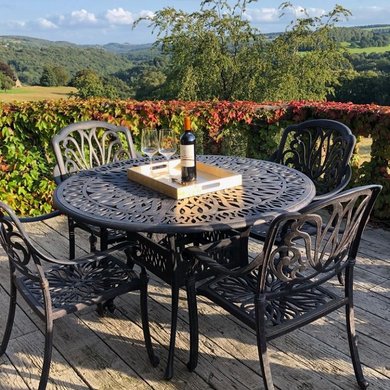Florence Nightingale Suites at Lea Hurst
Description
As Nightingale's bicentenary approaches, we have decided to offer the Nightingale Suite to guests keen to follow in her footsteps. Lea Hurst is also a convenient base from which to explore the delights of the Peak District.
We have 4 historic Suites to choose from, with detailed descriptions and images provided in the links below.
The Florence Nightingale Suite at Lea Hurst
This Suite comprises a large double bedroom, private bathroom and beautiful triple aspect sitting room. These are the rooms occupied by Florence Nightingale during her stays at Lea Hurst in the period following her return to England after the end of the Crimean War in 1856. Responding to the request by Queen Victoria, in the sitting room she wrote her substantial report on the causes of death in the Crimea. Upon its completion, she departed Lea Hurst to travel to Balmoral to present the report directly to Queen Victoria.
She spent much time in this Suite in the 1870s when she nursed her ailing mother at Lea Hurst.
The sitting room in particular has a strong sense of Florence Nightingale, as this is where she would have spent many hours writing letters and reports, directing the development and rollout of nursing schools throughout the country and beyond, lobbying for improved sanitation and healthcare for all sections of society, and influencing hospital design (including the Derby General Infirmary).
The Gaskell Family Suite at Lea Hurst
this Suite comprises 2 bedrooms, the principal bedroom with a balcony enjoying spectacular views over the surrounding countryside, and a private bathroom. This Suite is the childhood rooms of Florence Nightingale. There are a number of sketches and images of Florence standing on the windowsill, gazing out of the window which looks down the Derwent Valley, with her pet owl Athens standing beside her!
These are the rooms where Elizabeth Gaskell, the Victorian author and family friend, came to stay during the autumn of 1854, suffering from Writer’s block as she struggled to finish her novel, North and South, for her impatient publisher, Charles Dickens.
She wrote to her friend Catherine Winkworth on October 20th, 1854:
“ High as Lea Hurst is, one seems on a pinnacle, with the clouds careering round one. Down below is a garden with stone terraces and flights of steps – the planes of these terraces being perfectly gorgeous with masses of hollyhocks, dahlias, nasturtiums, geraniums etc. Then a sloping meadow losing itself in a steep wooded descent (such tints over the wood!) to the river Derwent, the rocks on the other side of which form the first distance, and are of a red colour streaked with misty purple. Beyond this, interlacing hills, forming three ranges of distance; the first, deep brown with decaying heather; the next, in some purple shadow, and the last catching some pale, watery sunlight.”
It was Gaskell who wrote to Nightingale 165 years ago this month, just before she departed for the Crimea, to break the sad news that her pet owl, Athena, has died.
The Parthenope Suite at Lea Hurst
This Suite comprises a double bedroom and large private bathroom, at the front of the house with lovely west-facing views over Nightingale Park. These are the rooms that would have been occupied by Florence’s elder sister, Parthenope. Parthenope married Sir Harry Verney (who had actually wanted to marry Florence) and subsequently moved to his home, Claydon House, in Buckinghamshire (now a National Trust property).
Standard capacity is 10 people (3 Suites, each with their own private bathrooms, plus the 2-bed family suite).
Maximum capacity: We have the ability to accommodate larger groups (up to 14 people) on request.
Dinner: For group bookings, we are happy to discuss the provision of a dinner, bed & breakfast arrangement.
Lea Hurst is set beautifully in the Derbyshire countryside. The house is immaculate and tastefully furnished with many images and artefacts related to Florence Nightingale and her family.





